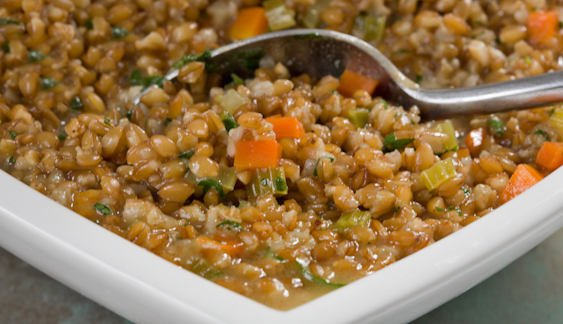Piccolo Farrotto

introduction
If you know risotto, you know farrotto. Farrotto mimics risotto’s cooking paths and borrows its luxuriously simple ingredients almost to the grain. Farrotto manages to capture risotto’s profound comfort quotient. But these two dishes from the Veneto are ultimately rather different. For one thing, farro manifests none of the demure, maidenly aspects of Arborio rice that demand a civilized interaction between you and your fork; farrotto virtually bounds off the tines and into your mouth, a muscular, robust, big wheaty presence. Whereas risotto graces plates of fish, veal, or chicken done in delicate sauces or braised, farrotto complements more ruggedly seasoned fare—grilled chicken, lamb, pork, or beef. Farrotto is meaty enough to fill in for a protein and pair with braised greens or scalloped sweet potatoes. The difference between risotto and farrotto is ultimately one of character.
Rice and farro have always had a symbiotic relationship. Both are true landraces—heirloom grains selected by farmers for their cultural and agricultural strengths over many centuries. The cultivation of farro as a protective winter cover crop in the vast rice fields of the Veneto helped it survive into modernity.
Cooking Remarks
Because farro like ours is a robust, resilient grain that can take hours to cook, most commercial farro has been pearled—like barley—to reduce its cooking time. This means that once it is hulled, part of its bran layer is scalped. When the bran layer goes, the flavor goes, too, and what remains is a chewy grain of almost pure starch. Anson Mills pearls no farro.
Ancestral harvesting practices, however, did prompt us to consider a modern approach to reduce farrotto’s stove time. Stay with us here, for a moment. Field workers used to thresh and hull farro beside the field, just like rice, to make a midday meal. They threshed the shocks or bundles by treading on them with their feet or flailing them over swept ground. The farro was then quickly hand pounded in a mortar to remove the hulls. The act of threshing and pounding cracked some of the grains and made them cook more quickly. Our version of this practice is considerably less romantic, but far more practical. We pulse the grains in a food processor to crack their bran layer. The farro is still not in any big rush to finish cooking—especially compared with rice—but the finish comes more quickly than it would without the food processor.
equipment mise en place
For this recipe, you will need a food processor, heavy-bottomed 2-quart saucepan and a heavy-bottomed 3- or 4-quart saucepan, a ladle, and a wooden spoon.
-
-
6ounces (1 cup) Anson Mills Farro Piccolo
-
1
-
1.25ounces (2½ tablespoons) unsalted butter
-
1large shallot, minced (3 tablespoons)
-
½cup dry red or white wine
-
½Turkish bay leaf
-
⅓cup finely diced celery
-
⅓cup finely diced carrot
-
2ounces (½ cup) finely grated Parmesan Reggiano
-
Fine sea salt and freshly ground black pepper
-
¼cup chopped fresh flat-leaf parsley
-
-
Turn the farro into a food processor and give it ten 1-second pulses to crack some of the bran that encases the grains. Transfer it to a small bowl.
-
Bring the stock to a simmer in a heavy-bottomed 2-quart saucepan over medium heat. Reduce the heat to low, cover the pan, and keep the stock just below a simmer as you cook the farro.
-
Melt the butter in a heavy-bottomed 3- or 4-quart saucepan over medium-low heat. Add the shallot and cook, stirring occasionally with a wooden spoon, until soft and translucent, about 5 minutes. Add the farro, increase the heat to medium, and stir until the grains are hot and coated with butter, about 1 minute. Stir in the wine and simmer until reduced to a glaze. Add the bay leaf and 1 cup of hot stock and stir once to make sure the grains are covered with liquid. Cook the farro, uncovered, at the barest simmer; when the liquid has been almost entirely absorbed and the farro begins to look dry, add another ½ cup of hot stock, stir once, and simmer until the liquid is absorbed and the farro once again begins to look dry. Cook the farro in this fashion for 1 hour. Stir in the celery and carrot and continue to cook, adding stock as needed, until the grains have expanded and are tender throughout, about 20 minutes longer.
-
Stir in the Parmesan, 1 teaspoon salt, and ½ teaspoon pepper. The farrotto should look creamy, not wet or soupy. Taste for seasoning. Stir in the parsley and serve immediately.